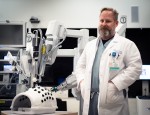Robotic surgery is expensive but its long-term health benefits might pay off in the long run.
Chris Childers, a general surgery resident at the Ronald Reagan UCLA Medical Center, analyzed financial statements of Intuitive Surgical, a leading surgery robot manufacturer, to evaluate how cost-effective robotic surgery is.
He published the results in a study in August showing robotic surgery is more expensive than nonrobot-assisted surgery. Intuitive Surgical released its 2018 financial data two weeks ago, which the study has recently taken into consideration.
Typically surgical robots cost around $2 million, Childers said. Instruments and accessories used in robotic surgery cost $866 more per procedure than nonrobotic procedures, according to the study.
Melinda Maggard Gibbons, a general surgeon who worked on the study, said purchasing and replacing disposable instruments such as scissors for individual robots also incurs an additional cost.
Childers said robotic surgery is expensive because instruments have to be constantly repurchased.
“You buy a robot (and you) have to buy a $2,000 contract with the company every year,” Childers said. “It costs almost $3,600 per operation.”
Though robotic operations are expensive, Erik Dutson, a general surgeon at the medical center with 18 years of robotic surgery experience, said they can actually save patients money.
“If you have a device that allows you to do a procedure or operation that … results in even one less complication over the course of a year, it basically pays for itself,” he said.
Childers said he believes robotic surgery will not only help reduce complications and costs for patients, but also cut down costs for hospitals.
“Let’s say you perform a robotic operation, the patient is in the hospital for less than a day. That saves money,” Childers said. “You don’t have to pay as much for staff.”
Robotic surgery reduces complications for patients because it is a minimally invasive procedure, said Mark Girgis, another general surgeon with advanced robotic training.
“Patients are able to get their surgery with smaller incisions, (which leads to a) theoretically faster recovery and less pain,” Girgis said.
Girgis said Intuitive Surgical has a monopoly on the surgical robot market right now. However, as technology advances and more companies produce robots, Girgis said he thinks the cost of robotic surgery will decrease.
“How we feel about (robotic surgery) now is not going to be the same as how we feel about it 10 years from now when other companies come out with their own robots that compete with the monopoly that (Intuitive Surgical has) right now,” Girgis said.
Childers said he believes robots will become standard in operating rooms in the future.
“Robots are only going to get more prevalent as you go on,” Childers said. “No one is going to just be doing bare, hard surgery 50 years from now.”
Dutson said he thinks robots will one day completely replace human surgeons.
“We’re already working on ways to do automated gestures … medical robotics are going to have an increasing level of autonomy,” Dutson said. “Robots are going to replace everybody in every field that we have right now, and it’s going to be driven by artificial intelligence more than anything.”

Thank you for this article about the benefits of robotic surgery. You should be aware of the Senhance Surgical System, from Morrisville, NC-based, TransEnterix. The Senhance System is the first & only abdominal robotic surgery system to receive FDA Clearance & enter the market since 2000. It is also the first & only digital laparoscopic platform that offers haptic feedback, eye-tracking camera control & reusable instruments, as well as 3 mm instruments for macrolaparoscopic procedures.
These advanced technologies unique to the Senhance System are paving the way to the future of robotic surgery by improving the patient and surgeon experience, while helping to lower per-procedure costs.
The Senhance System also seamlessly incorporates the Senhance Ultrasonic System–an advanced energy device that allows the surgeon to perform precise dissection combined with hemostasis of tissues through the use of torsional ultrasonic energy. Ultimately protecting surrounding tissues from potentially harmful thermal spread.
By digitizing the interface between existing laparoscopic technologies, the Senhance System offers surgeons control without compromise. Surgeons are not required to make trade-offs between current tools or techniques they use and are afforded improved features, such as eye-tracking camera control, a digital fulcrum to help minimize incision trauma, and better ergonomics, all of which are designed to meet the constraints of today’s value-based health care landscape.
Yes, Intuitive’s razor and blade business model has proven successful for almost 20 years. But their system has limited indications and doesn’t offer hospitals the ability to lower per procedure costs with such features as reusable and/or 3 mm instruments.
Furthermore, the Senhance System also addresses the larger, more pressing issue of surgeon burnout. The Association of American Medical Colleges forecasts a deficit between 33,500 and 61,800 surgeons and specialists by 2030.
With the da Vinci, surgeons must often remain in awkward positions for long periods of time + an assistant is needed to move the camera throughout the operating field, forcing the surgeon to stop while camera adjustments are made. Whereas the Senhance System features eye-tracking camera control that allows the camera to move with the surgeon’s eye movement.
The technology of the Senhance System is ushering a new era of MIS by offering a robotic platform that can be used in a vast majority of laparoscopic procedures, with OR times similar to laparoscopy and a per-procedure cost that is comparable to standard laparoscopy.
Please correct should say $200,000 not $2,000!
You buy a robot (and you) have to buy a $2,000 contract with the company every year,” Childers said. “It costs almost $3,600 per operation.”